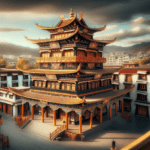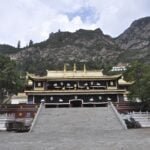Overview of Juebaigar Temple
Location and Altitude: Juebaigar Temple, nestled in the scenic Kemapu Valley of Douyu Township, Longzi County, sits at an altitude of 3160 meters. The temple, established between the 13th and 14th centuries, is an exemplar of early Tibetan monastic architecture.
Architectural Features of Juebaigar Temple
Orientation and Structure: The temple is designed with an east-facing orientation, typical of many Tibetan temples, and is constructed using stone walls. The overall layout of the temple is characterized by a distinctive “convex” shape on the plane, integrating seamlessly with its natural surroundings.
Porch and Courtyard:
- Porch: Located on the east side of the temple, the porch covers an area of about 16 square meters, serving as the entrance to the temple complex.
- Courtyard: Beyond the porch lies a spacious courtyard, stretching over 320 square meters (20 meters in length and 16 meters in width). This area forms the heart of the temple, providing a serene space for meditation and gatherings.
Lakang and Prayer Path:
- Lakang (Prayer Hall): Situated on the west side of the building complex, the Lakang features four columns, measures 8.4 meters in width and 7 meters in depth, and has a door opening to the east.
- Buddhist Altar: The western wall of Lakang houses a naturally formed stone statue of Sakyamuni Buddha, measuring 93 cm in height, 75 cm in width, and 20 cm in thickness, positioned in the Xumizuo pose.
Cultural and Spiritual Significance
Mani Wall: Encircling the main building wall is a “Mani Wall,” a significant spiritual and cultural element in Tibetan Buddhism. This wall is adorned with engravings of the “Six-Character Mantra” in both Sanskrit and Tibetan (ma-ni-yig-drug), along with diamond mantras and sutra mantras. The presence of these mantras symbolizes the temple’s dedication to spiritual practices and the dissemination of Buddhist teachings.
Juebaigar Temple, with its unique architectural design, serene courtyard, and spiritually adorned Mani Wall, stands as a beacon of Tibetan Buddhism’s rich history and cultural heritage. The temple’s integration of natural elements, like the stone statue of Sakyamuni Buddha, further accentuates its harmonious relationship with the surrounding landscape, making it a distinctive and revered site in Tibetan religious and cultural tradition.
Highlights of Juebaigar Temple’s Murals
① Lakang Murals: A Display of Protector Deities and Sacred Imagery
East Wall:
- Protector God Statue: This wall features a depiction of a protector god, an important figure in Tibetan Buddhism known for safeguarding the Dharma and its practitioners.
South Wall:
- Protector Vajra: Illustrated with a tiger skin skirt, standing on a lotus platform. This image symbolizes power and spiritual authority.
- Surrounding Figures: The painting includes images of eminent monks and Tara among clouds, signifying their revered status in the Buddhist pantheon.
- Symbolic Patterns: Below these figures is a white line drawing of the “卍” (Yongzhong, g.yung-drung) symbol, accompanied by eight treasure patterns, each bearing significant spiritual meanings.
North Wall:
- Small Protector Statue: Adds to the array of guardian figures within the temple, reinforcing its role as a spiritual stronghold.
② Murals in the Prayer Corridors: Artistic Narratives Along the Path
South Wall:
- Master Padmasambhava and Dakini: Central to this mural is Master Padmasambhava, a revered figure in Tibetan Buddhism, depicted with his Dakini, symbolizing the union of wisdom and compassion.
- Main Figure: Holding a vase in both hands and seated in a lotus position on a lotus platform, representing spiritual purity and enlightenment.
- Disciple Portraits: At the eastern end, four disciples are portrayed, with the upper two in monks’ hats and the lower two in beards and monks’ robes, highlighting the diversity of Padmasambhava’s followers.
West Wall:
- Protector Statue: Featuring a deity holding a snake in the left hand and a vajra in the right, adorned with a skull crown and seated on a lotus platform, symbolizing the transformation of negative energies into wisdom.
- Other Figures: Includes the lotus flower, Vajra Chan, and a group of eminent monks, each carrying specific symbolic meanings within the Buddhist context.
North Wall:
- Tara, Blue God Iku, and Sakyamuni Buddha: These figures represent different aspects of Buddhist teachings and virtues.
- Dharma Protector Vajra: Positioned above, guarding the teachings, with disciples depicted below, signifying the transmission of knowledge.
Conclusion
The murals in Juebaigar Temple’s Lakang and prayer corridors offer a rich tapestry of Tibetan Buddhist iconography, combining spiritual symbolism with artistic excellence. These paintings not only adorn the temple walls but also serve as visual narratives, encapsulating key teachings, figures, and symbols of Tibetan Buddhism. They are a testament to the temple’s role as a center of spiritual learning and preservation of Buddhist art and culture.















